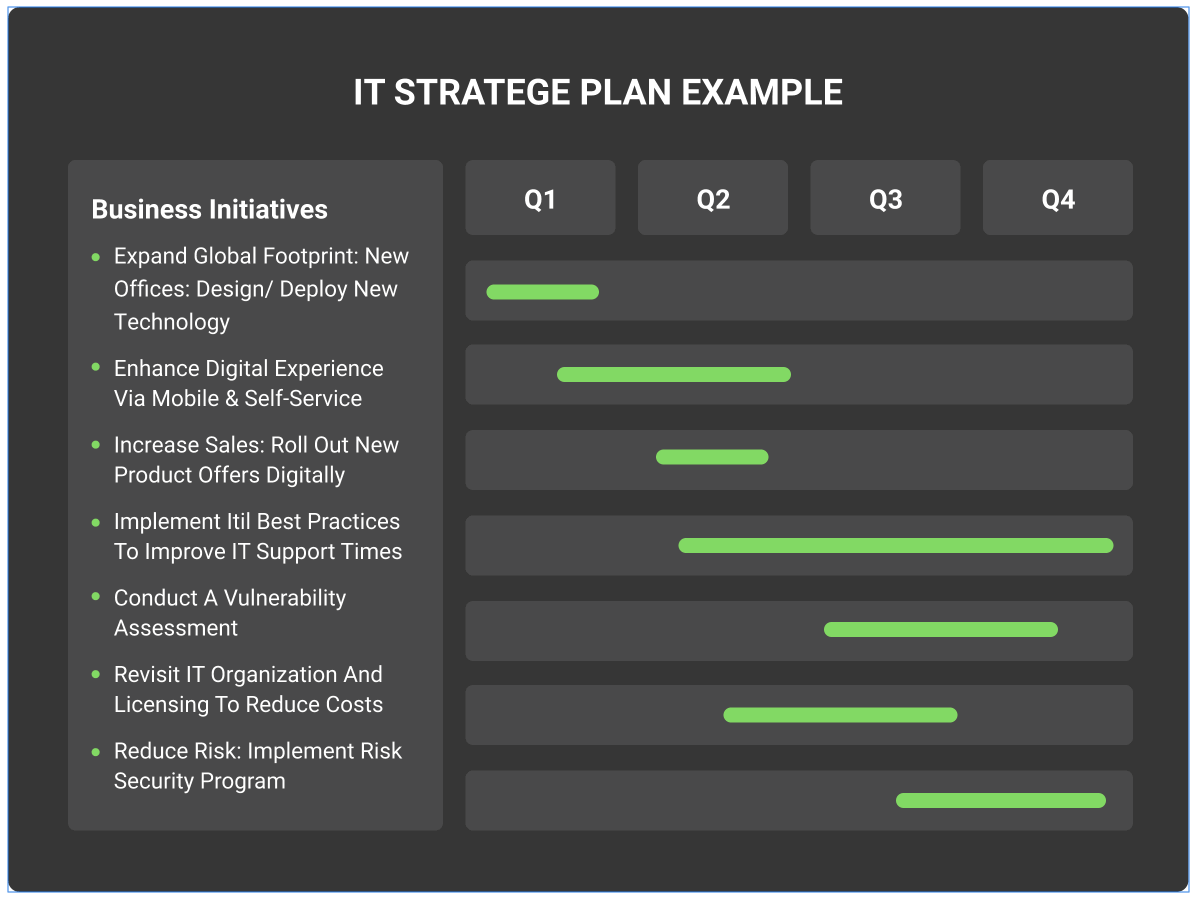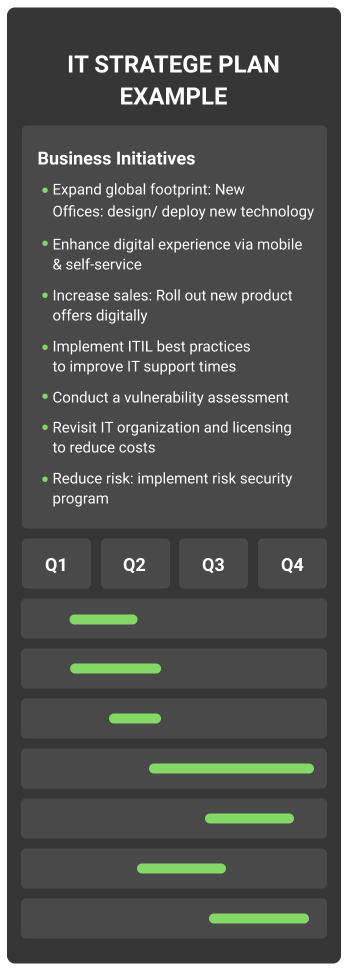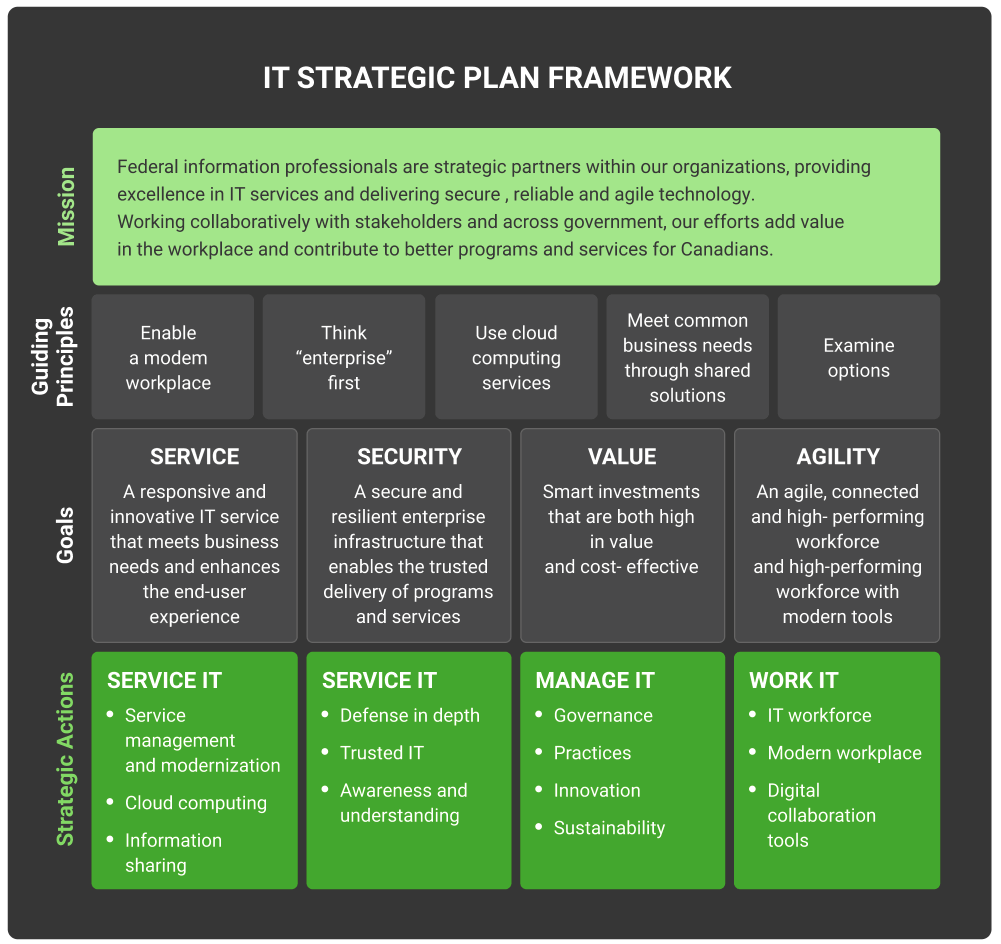As they grow, many companies find it very beneficial to have their own IT department. IT planning becomes just as important as creating a financial plan or budget forecasting. Adequate IT planning takes time, but this process allows all department resources to be productively utilized. With a strong IT strategy, the company will more effectively achieve its business goals, prevent a number of internal problems, and even reduce the cost of maintaining hardware and other components. You definitely need to take care of IT planning if you want to use company funds more efficiently, increase profits, optimize resources, and improve overall productivity.
A man who does not plan long ahead will find trouble at his door.
– Confucius
What Is an IT Strategic Business Plan


An IT strategic plan is a dynamic document that describes complex procedures and processes for managing a business based on existing technologies. By using such a plan, top management can make a number of decisions regarding the IT direction of the company, including setting goals and priorities. In general, the IT business planning process helps in creating an overall company strategy. It should include those IT areas in which you can contribute and gain a competitive advantage.
Waze is an excellent example of a sound IT strategy and planning. This application was created in 2006 by an Israeli developer Ehud Shabtai and reflected the map of Israel for use in GPS technology. It would seem that there were a lot of similar applications. Still, the company focused on its IT strategy, and already in 2011 released an update that showed the congestion of routes, traffic incidents on the map, rallies, and laid the most effective course for users, taking into account the traffic situation. Waze quickly gained popularity due to its convenient function, and in 2013 it was purchased by Google for $1.1 billion.
In 2020-2021, IT planning is more critical than ever. Given the rapid development of information technology and its impact on business, each organization must clearly understand its strategic goal and how the technical area is moving.
What a Strategic IT Plan is Not
It is imperative to understand what a strategic plan is and not confuse it with a tactical one. Otherwise, it will fail. An Information Technology strategic plan is the framework from which executives decide to meet the overall business strategy. It is a key point for business development. A tactical plan, which guides what needs to be done to achieve a goal, is still not a strategic plan.
Another remarkable nuance is that a strategic plan is not a static document. We said earlier that it is dynamic, which means that it must be revised and updated per the company’s needs. You cannot just create it once and then follow it all the time. Ideally, you should revise and modify a 5-year IT strategy plan annually.
What Components an IT Plan Should Cover
It is a mistake to think that IT plans only cover software and hardware resources. In fact, it is much wider. A strong document should contain the following aspects:
Alignment with business strategy and objectives. The IT strategy must support the business strategy, and this is what the IT plan reflects. It is worth highlighting those business strategies that require significant investments in IT infrastructure or related aspects.
Long-term initiatives. Long-term perspectives take from 3 to 5 years to reach and should also be reflected in the plan. Long-term prospects must also be consistent with the goals and direction of the company. For example, if we are talking about creating a custom application, then the company can build development from scratch or expand the current one. Another option when resources are limited is to hire a third-party company for custom software development.
Best practices. It is one of the factors influencing the success of a company in compliance with advanced technologies. The IT plan should clearly define the company’s new practices and a program for its implementation. It takes time, namely training of personnel, and requires the purchase of appropriate software or equipment, and so on. Nevertheless, this is an important point that affects the competitiveness of a business.
IT governance. This section identifies IT management issues and describes how to improve them. Good governance is directly related to how a company creates, evaluates, implements, and manages new initiatives and best practices.
IT service catalog. The company must implement a service catalog that will support the business and help it grow. These can be additional services that are not related to the central IT product but aimed at improving the organization's performance; for example, a company will decide to move towards SaaS development services. Besides, this section should also cover any problems that exist in the current IT service catalog and ways to fix them.
Ways of communication. Any business needs to have established ways of communicating with clients to demonstrate the transparency of its services. Good communication increases the level of trust in the organization. Thus, another part of the IT plan is how to inform customers about the services provided and their implementation.
IT principles, metrics, and financials. In order to see the performance, a business evaluates its indicators. This section should answer questions such as: What are the guidelines for IT? What are the key metrics that represent business performance? How does a company measure its success? Which budget model to use? By and large, this part should be interconnected with the overall financial model of the company.
Holistic design. The next component contains the design principles that must be followed in every IT project for successful delivery and an overall testing strategy.
Human capital management. Any human resource is an asset that needs to be well-managed to achieve maximum productivity. The plan should describe the strategy for managing human resources with the help of technologies, equipment, or related applications.
Enterprise risk management. Any business can face situations that negatively affect development and profit. Thus, the workable plan should contain a forecast of adverse events and specific steps to prevent them or reduce their impact to a minimum and measures to secure the company.
Cost management. The next component is the description of cost management. In general, in any company, this is an extensive section. An IT plan describes how a company can manage costs and how they depend on hardware or software.
Technology management. The next equally important part describes how the company maintains, updates, and manages technology, databases, networks, and IT security services and creates a contingency plan, manages appropriate documents, etc.
Hardware and software management. This section describes how the company will maintain and update software and hardware, specifications, licenses, configurations, etc. Quite often, this part of the plan overlaps with the previous section.
Vendor management. In the next part, you need to identify and manage the activities of third-party providers that affect the IT department. This includes complying with various kinds of agreements, as well as managing day-to-day activities.
Need a professional IT team to benefit your business? Hire KeyUA experts with 12+ years of experience developing sophisticated products.
Contact UsWhy Do You Need the IT Plan


Every organization that is interested in their business growth and gaining a competitive advantage should take care of creating an IT plan. It can significantly increase productivity and achieve important business goals. Companies that do not have an IT plan or do not update their plan regularly are exposed to high risks and poor business processes. Here are some other reasons for developing an IT strategic plan:
You can avoid such unpleasant situations as data theft, negative consequences of hacker attacks, viruses. Outdated technology is what will make your company vulnerable and what could sink it. An IT plan will help you develop accurate and actionable methods to secure your business from outside interference.
Increase in productivity based on reducing the time required to respond to problems associated with internal software or hardware, IT products developed by the company, etc.
Efficient use of resources. An IT plan will help you qualitatively manage the business’s internal components, including human resources and equipment, taking into account the company’s needs. In turn, this will lead to the minimization of the costs and risks associated with incompetent management. Basically, if you want your staff and your hardware to be the best, you need an IT plan.
Receiving additional investments. Lenders, investors, and other financial institutions will be more likely to provide you with additional financing if you have a clear and well thought out strategic IT plan that matches the organization’s real-time needs. From an investment point of view, a good IT plan increases the opportunities for making a profit.
You can easily find alternative and more cost-effective hardware options on the market. Good planning helps you avoid cost overruns and find the best solution.
Always be prepared for unforeseen circumstances. Yes, a strategic plan allows you to cope with negative changes for which the company was not ready and to minimize their consequences.
A strategic plan is an opportunity to look into the future and determine the most effective ways of business development. Let's take a look at the competition between Netflix and Blockbuster video. Blockbuster had over 9,000 stores in various countries at its peak, including over 4,000 in the United States. Netflix began its activity as the world's first online DVD rental shop. But in 2007, the company looked ahead and predicted that video streaming would be the right direction for its business. And what is now? More than 139 million users worldwide purchase Netflix subscriptions, and the company generates $6.148B in revenue per quarter. In 2013, Blockbuster closed its last store. This is a prime example of how important it is to have a strategic plan focused on future trends.
The 6 Stages of the IT Strategic Planning Process
Now we know that an IT plan is an important document for business development, supporting the company’s overall expansion strategy. Now let's look at the main steps on how to develop an IT strategy plan.
1. Planning process overview
This stage shows where the company as a whole should move. Senior management defines the mission and long-term prospects of the IT direction. In the beginning, these statements should show how the plan relates to the overall business strategy.
2. Long-term vision of the company
At this stage, the assets and resources of the company are defined. This is where human capital and technical capabilities are handled. It is equally important to make a market forecast and identify future technology trends and goals that the company will achieve.
3. Identifying current problems
You should study the current state of all systems and processes in the IT direction, find bottlenecks, and understand how this affects the business. For all identified problems, an effective solution must be found.
4. Schedules and budget
This stage includes building a roadmap, budgeting, prioritization, as well as ways to obtain investment.
5. Process of strategic IT planning
Based on the data analysis and the problems identified, the company must make a number of important decisions. This includes staff training, selection of the best suppliers, equipment procurement, IT infrastructure setup, and so on.
6. Benchmarking
The company must track its progress and how it managed or failed to achieve its goals. At the last stage of the planning process, it is worth comparing the company's results with the goals from previous plans and understanding whether they were achieved. If the organization has not reached the intended purposes in the previous period, it is worth assessing if they are still relevant and developing steps to realize them.
Example from the Government of Canada Information Technology Strategic Plan 2016-2020

A Couple of Basic Nuances to Focus On
Several aspects do not seem so significant, but they should definitely be focused on during the preparation of the IT Plan. As in most areas of business, IT is a team effort, and often even the smallest companies have several dedicated professionals. Ideally, the IT department comprises various experts in software development, infrastructure customization, data protection, and so on. But not all companies can afford such a staff, so they make the mistake of dumping all responsibility on one IT specialist. Even if the company’s department is small, you need to ensure that its roles are correctly assigned, and the internal structure is efficient. At first glance, it might seem like a confusing waste of time. But the wrong structure and distribution of responsibility will lead to the most failure of the entire department. Take care of it even if you hire remote specialists.
Process management is a significant part of business development. Good governance will lead to success, while the wrong actions will lead to the bankruptcy of the organization. The same applies to IT process management. While strategic planning should take place annually, it must also cover the oversight and adjustment of internal IT processes every quarter or six months depending on the company’s size.
Final Words
If you don't have an IT plan yet, you should take care of its creation to help your company grow and reduce costs. We hope you find these tips for IT business planning useful and can apply them in practice. But not all companies consider it reasonable to build their own IT department, instead choosing to hire a professional outsourcing team that can realize the set goals. If you belong to this type of business owner, we have lucrative offers to create web or mobile products of any complexity.
Want to build a custom app and conquer the market? Ask us how!
Contact Us








 Unit 1505 124 City Road, London, United Kingdom, EC1V 2NX
Unit 1505 124 City Road, London, United Kingdom, EC1V 2NX

Comments
Leave a comment